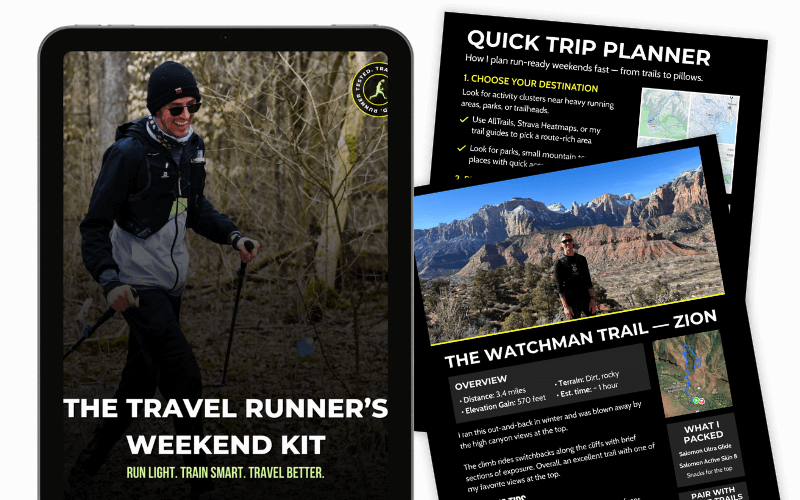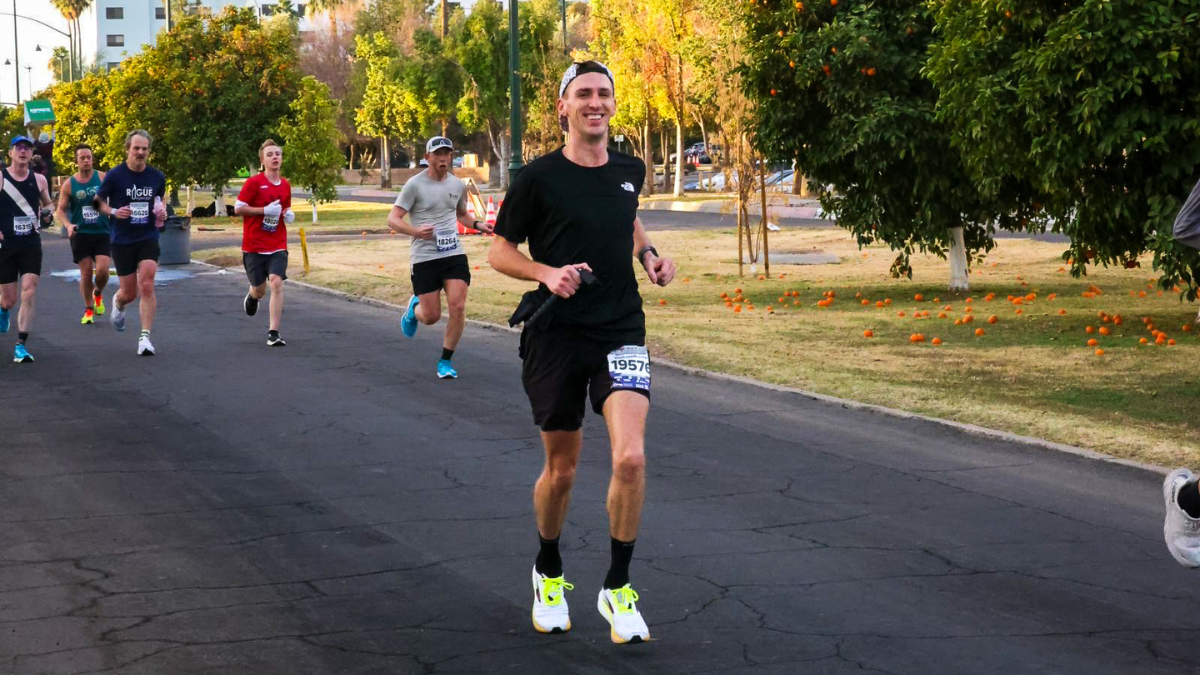Gear & Logistics
Running and traveling — two things that go together like peanut butter and jelly. Or, if you’re me, like a long run and a giant post-run meal.
But let’s be real: fitting in runs while traveling isn’t always easy. New places, packed schedules, and the temptation of sleeping in throws off even the most dedicated runners. I’ve been there — standing in a city I’ve never been to, trying to figure out where to run without getting lost, ending up miles from where I’m staying with no idea how to get back, or ending up in the middle of rush hour traffic. It’s a delicate balance for the perfect runcation.
But that’s why I put together this guide. Whether you’re squeezing in miles on a work trip, training for a race while backpacking, or just want to explore new destinations on foot, these 11 tips will help you run smarter, safer, and stress-free — no matter where you are.
Lace up, and let’s get into it.
Disclosure: Just a heads-up, The Travel Runner earns a little commission if you buy through some links here, but it won’t cost you anything extra. Thanks for your support!

Ready for Your Next Runcation?
Grab my Runner’s Weekend Kit — a free bundle with ready-to-run itineraries, my personal packing checklist, and a quick planner to turn your next weekend trip into a running adventure.
A guide to running while traveling
1. Plan routes in advance
Spontaneity is great…until you find yourself running on the side of a road that doesn’t normally see runners. (Yeah, I’ve learned that one the hard way.)
Before you even leave on your rip, take a some time to map out routes. My favorite apps for this are Strava and AllTrails. Not only do you get an entire library of options with AllTrails, but Strava’s heatmaps are a travelers best friend. With it, you can see where most runners run in the area (as long as they use Strava). I’ve used this in countless countries and states to find a quick route or which areas to visit based on how “hot” it is. Check out the next section for a picture of Strava’s heatmaps.

Also, scout out routes via local running groups or race routes. And if all else fails? Ask the front desk at your hotel. They’ve probably been asked before and might have some solid recommendations!
A little planning goes a long way toward making sure your run is actually enjoyable—and not an unexpected game of “let’s see where this road takes me.” Don’t get me wrong, this can be fun. But it can also be very un-fun (and potentially dangerous).
2. Find accommodation near running areas
I started doing this about five years ago, and honestly? Game-changer.
If I’m traveling somewhere specifically to run, why not make it as easy as possible? Now, before I book a place, I pull up Strava and AllTrails to see where the best running routes are clustered. Once I’ve found the sweet spot, I cross-check it with Airbnb or Expedia and try to land a stay right in the middle of the action.

I did this on a trip to Costa Rica, and it led me straight to Parque Sabana in San Jose — a perfect little park in the middle of the city that I went to for multiple runs (it helped it was minutes from my Airbnb). Having a solid running spot right outside my door made it so much easier to stick to my routine, instead of having to Uber somewhere just to get a few miles in.
This is hands-down one of my favorite travel-running hacks. If you’re serious about getting your miles in, picking the right home base makes all the difference.
3. Pack your running gear in a smart way
Packing for travel running is a fine art — you want to be ready for anything without overstuffing your bag like you’re moving cross-country.
Versatility is key. Your running gear should handle different weather conditions but still be lightweight and packable. I always make sure to have a “cold option” — whether that’s a light running jacket or thermal layers — because nothing ruins a run faster than being underdressed in unexpected temps.

And when it comes to shoes. If you have the space, bringing a pair of packable running shoes can make things way easier. Some shoes pack down better than others, so if you’re tight on space, consider a more compact option that still gives you the support you need. When I know I’m trail running, I’ll typically pack them in my carry-on and then wear my road shoes on the plane. Double the shoes for less space.
If you want a full breakdown of my go-to trail gear, this post gives more details on my trail gear.
4. Prioritize safety
This one’s broad, but it’s also one of the most important tips for running while traveling—especially for trail running safety.
A few things I always do to stay safe:
✅ Tell someone where I’m going – I always let someone know my route (usually my fiancee) and when I’ll be back. If there aren’t any options, tell the hotel front desk or text a friend, it’s worth the extra step.
✅ Stick to populated areas – If I’m running alone at night in an unfamiliar place, I stick to well-lit areas with other people around. More people = more safety.
✅ Carry the essentials – I always bring my ID, a little cash (just in case), and my phone. That way, I’m covered for emergencies, post-run snacks, or an unexpected detour.
✅ Check the weather forecast – Nothing like starting a run in sunshine and ending in a downpour. I’ve had it happen, and trust me, it’s not fun. A quick check before you head out can save you.
Running and sightseeing isn’t all that different from running at home — you just need to take a few extra precautions. Do that, and you’ll be all set to enjoy the miles worry-free.
5. Be flexible
Travel is unpredictable.
Running while traveling? Even more unpredictable.
That’s why the key is to stay flexible and fit in miles whenever you can. Maybe it’s a quick morning jog before the city wakes up, or maybe it’s an evening shakeout run while exploring new streets. Either way—go with the flow and have fun with it. Personally, I’m an early morning runner. I’ve found that getting my miles in first thing makes it way easier to stay consistent. Plus, early runs usually mean quieter streets, cooler temps, and getting to see a city before the crowds take over.

Bottom line? Don’t stress about sticking to a perfect training schedule. Roll with the punches, adjust as needed, and enjoy the freedom of running in new places.
Now get out there and explore
Running while traveling is easily one of my favorite things (if you couldn’t tell by the website name). But what makes it even better? Sharing the experience with others.
I hope this guide helps you make the most of your miles on the road. If you’re on the hunt for the perfect travel running shoes, check out my post on the best trail running shoes for travel — it’ll help narrow things down.
Now, I want to hear from you! Where’s the coolest place you’ve ever run? Drop a comment below and share your favorite destination race, scenic route, or unexpected gem. I’m always looking for new places to add to my list!
And if you want more travel-running tips, routes, and stories, sign up for my newsletter—I’ll send everything straight to your inbox. No spam, just the good stuff.
See you out there! ?✈️

Kyle Cash | Trail Journal
I’m Kyle — the runner behind The Travel Runner. I run trails all over the world to bring you stories, tips, and gear that actually works. From national parks to forgotten paths, I’ve got mud on my shoes and too many snacks in my pack.
Let’s go find new ground.


Leave a Reply